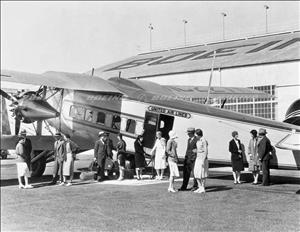On January 28, 1927, Boeing wins a federal air mail contract for Chicago-San Francisco route. This leads to the development of a new generation of passenger aircraft and later to the establishment of United Air Lines.
Regular U.S. Air Mail service was inaugurated on May 15, 1919, and government-owned aircraft transported the mail. Following the passage of the Kelly Act in 1925, the U.S. Post Office began contracting with private companies to carry mail on designated routes. Growing numbers of passengers went along for the ride. These coveted franchises created the basis for the airline industry in much the same way that land grants and mail contracts had built the nation's railway system.
When bids were requested for the Chicago-San Francisco route ("CAM-18") on November 25, 1926, veteran mail pilot Eddie Hubbard (1889-1928) recognized that Boeing had the perfect aircraft for the job, the Model 40 high-speed biplane. He persuaded a skeptical William E. Boeing (1881-1956) to bid on the route. The company won with the bargain rate of $1.50 per pound of mail.
The new Boeing Air Transport Corporation (also called Boeing System) inaugurated service with two-dozen Model 40As on July 1, 1927. Soon after, Boeing acquired Vern Gorst's Pacific Air Transport and began to form United Air Lines. Boeing introduced larger Model 80 trimotor airplanes, the first "stewardesses" (originally registered nurses), and the revolutionary Model 247 airliner over the next seven years. Under pressure from Congress and anti-trust regulators, Boeing was forced to spin off United Air Lines and other holdings in 1934. An embittered William E. Boeing sold his stock and left the aviation industry that he had helped to create.

